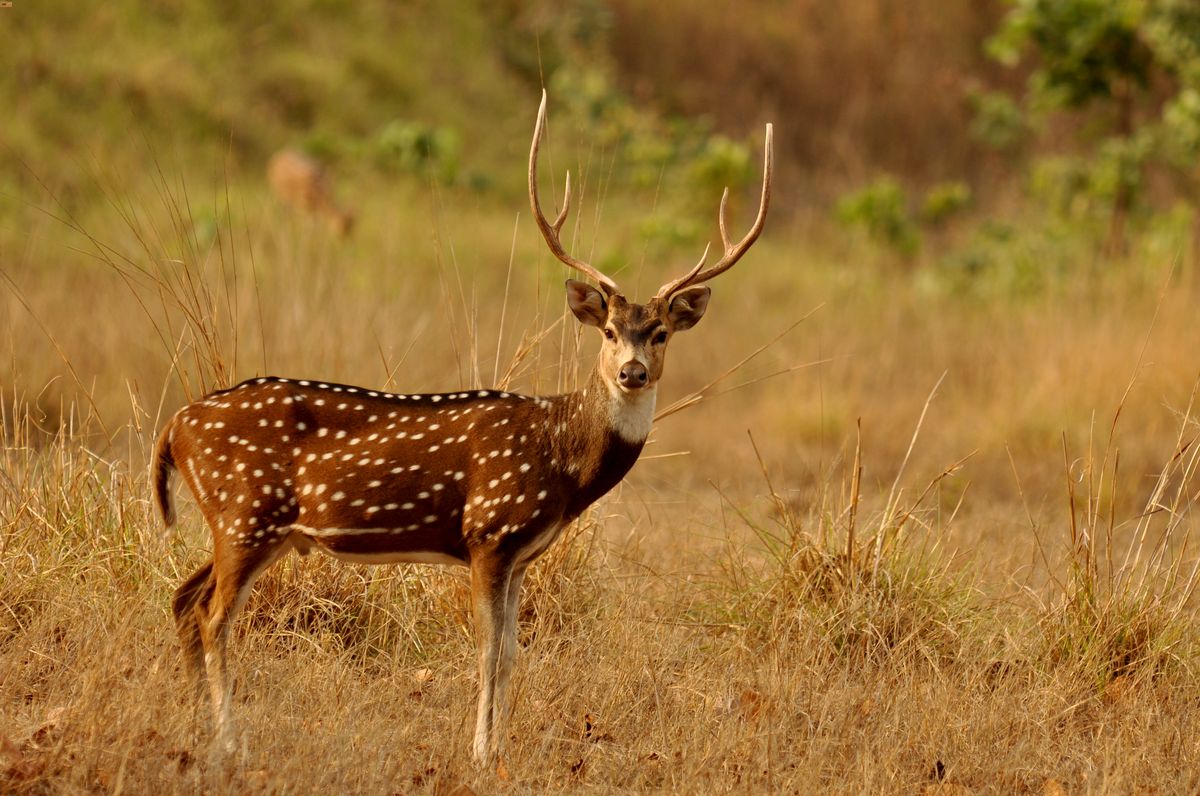
Chital, also known as the spotted deer or axis deer, is a captivating creature found in the forests of India, Nepal, Sri Lanka, Bhutan, and Bangladesh. These graceful animals are easily recognized by their white spots and reddish-brown coats. Chital are social animals, often seen in herds led by a dominant male. They are primarily grazers, feeding on grasses, leaves, and fruits. Interestingly, they have a symbiotic relationship with langur monkeys, who drop fruits from trees for the deer to eat. Chital are also known for their distinctive alarm calls, which alert other animals to the presence of predators like tigers and leopards. Their beauty and behavior make them a fascinating subject for wildlife enthusiasts and researchers alike.
Chital: The Spotted Beauty of the Forest
Chital, also known as the spotted deer or axis deer, is one of the most beautiful and recognizable deer species. Their striking appearance and fascinating behaviors make them a favorite among wildlife enthusiasts.
-
Chital are native to the Indian subcontinent, found in India, Nepal, Bhutan, Bangladesh, and Sri Lanka.
-
The scientific name for chital is Axis axis.
-
Chital have a reddish-brown coat adorned with white spots, which helps them blend into their forest habitats.
-
Males have antlers that can grow up to 3 feet long and are shed annually.
-
Unlike many other deer species, chital are active both day and night.
Social Structure and Behavior
Chital are social animals, often seen in large herds. Their social structure and behaviors are intriguing and complex.
-
Herds can consist of up to 100 individuals, though smaller groups of 10-30 are more common.
-
A typical herd includes females, their young, and a few males.
-
Males often form bachelor groups when not in the breeding season.
-
Chital communicate using a variety of vocalizations, including barks, mews, and alarm calls.
-
They are known to form symbiotic relationships with langur monkeys, who help them spot predators.
Diet and Feeding Habits
Chital have a varied diet that changes with the seasons. Their feeding habits are essential for maintaining the balance of their ecosystem.
-
They are primarily grazers, feeding on grasses, leaves, and fruits.
-
During the dry season, chital may also consume tree bark and shrubs.
-
Water is crucial for their survival, and they are often found near water sources.
-
Chital play a role in seed dispersal, helping to propagate various plant species.
-
They have a four-chambered stomach, which allows them to digest tough plant material efficiently.
Reproduction and Lifespan
Understanding the reproductive habits and lifespan of chital provides insight into their population dynamics and conservation needs.
-
The breeding season for chital varies by region but generally peaks during the monsoon season.
-
Males compete for females through displays of strength and antler wrestling.
-
After a gestation period of about 7-8 months, females give birth to a single fawn.
-
Fawns are born with a spotted coat, which provides camouflage from predators.
-
Chital can live up to 10-15 years in the wild, though many fall prey to predators before reaching old age.
Predators and Threats
Chital face numerous threats in the wild, from natural predators to human activities.
-
Their primary predators include tigers, leopards, and wild dogs.
-
Humans pose a significant threat through habitat destruction and poaching.
-
Chital are also susceptible to diseases such as foot-and-mouth disease.
-
Conservation efforts are in place to protect chital populations, including protected areas and wildlife reserves.
Interesting Tidbits
Here are some lesser-known facts about chital that highlight their unique characteristics and behaviors.
-
Chital are excellent swimmers and can cross rivers to escape predators or find new feeding grounds.
-
They have a keen sense of smell and hearing, which helps them detect danger.
-
Chital are known to engage in mutual grooming, which strengthens social bonds within the herd.
-
Their alarm calls can alert other animals in the forest to the presence of predators.
-
In some cultures, chital are considered symbols of grace and beauty, often featured in folklore and art.
Final Thoughts on Chital Deer
Chital deer, also known as spotted deer, are fascinating creatures. Their distinctive spots and graceful movements make them stand out in the wild. Native to India and Sri Lanka, these deer have adapted well to various environments, including grasslands and forests. They are social animals, often seen in herds, and have a diet primarily consisting of grasses and leaves.
One interesting fact is their symbiotic relationship with langur monkeys. The monkeys drop fruits and leaves from trees, which the deer then eat. In return, the deer alert the monkeys to potential dangers. This mutualistic relationship highlights the intricate connections within ecosystems.
Understanding these deer helps us appreciate the biodiversity of our planet. Protecting their habitats ensures that future generations can witness their beauty. So next time you spot a chital deer, remember these facts and the important role they play in nature.
Was this page helpful?
Our commitment to delivering trustworthy and engaging content is at the heart of what we do. Each fact on our site is contributed by real users like you, bringing a wealth of diverse insights and information. To ensure the highest standards of accuracy and reliability, our dedicated editors meticulously review each submission. This process guarantees that the facts we share are not only fascinating but also credible. Trust in our commitment to quality and authenticity as you explore and learn with us.
